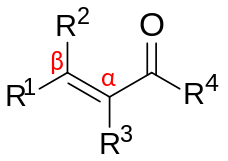α,β-Unsaturated carbonyl compound

R2 & R4 can also be single hydrogens.
α,β-Unsaturated carbonyl compounds are
Classifications
α,β-Unsaturated carbonyl compounds can be subclassified according to the nature of the carbonyl and alkene groups.
- Parent α,β-Unsaturated Carbonyls
-
Methyl vinyl ketone, the simplest α,β-unsaturated ketone
-
Acrolein, the simplest α,β-unsaturated aldehyde
-
Methyl acrylate, an α,β-unsaturated ester
-
Acrylamide, precursor to polyacrylamide
-
Maleic acid, an α,β-unsaturated dicarbonyl
-
Fumaric acid, isomeric with maleic acid
Acryloyl group

α,β-Unsaturated carbonyl compounds featuring a carbonyl conjugated to an alkene that is terminal, or
α,β-Unsaturated acids, esters, and amides
An α,β-unsaturated acid is a type of α,β-unsaturated carbonyl compound that consists of an
α,β-Unsaturated dicarbonyls are also common. The parent compounds are
Enones
An enone (or alkenone) is an organic compound containing both

Cyclic enones
The cyclic enones include cyclopropenone, cyclobutenone,[6] cyclopentenone, cyclohexenone, and cycloheptenone.[7]
Enals
An enal (or alkenal) is an organic compound containing both alkene and aldehyde functional groups. In an α,β-unsaturated enal, the alkene is conjugated to the carbonyl group of the aldehyde (formyl group).[3] The simplest enal is acrolein (CH2=CHCHO). Other examples include cis-3-hexenal (essence of mowed lawns) and cinnamaldehyde (essence of cinnamon).
- Other α,β-Unsaturated Carbonyls
-
E-Crotonaldehyde, an enal that exists as an isomer
-
Cyclohexenone, common cyclic enone
-
testosterone, the male sex hormone
-
Cinnamaldehyde, essence of cinnamon
-
Paraquinone, a particularly electrophilic α,β-unsaturated carbonyl
-
Enone complex of iron tricarbonyl
Reactions of α,β-unsaturated carbonyls
α,β-Unsaturated carbonyls are
α,β-Unsaturated carbonyls are readily hydrogenated. Hydrogenation can target the carbonyl or the alkene (
Enones undergo the Nazarov cyclization reaction and in the Rauhut–Currier reaction (dimerization).
α,β-Unsaturated thioesters
α,β-Unsaturated thioesters are intermediates in several enzymatic processes. Two prominent examples are

Safety
Since α,β-unsaturated compounds are electrophiles and alkylating agents, many α,β-unsaturated carbonyl compounds are toxic. The endogenous scavenger compound
See also
References
- ISBN 9780470772218.
- ISBN 9780470772225.
- ^ ISBN 978-0-471-72091-1
- ISBN 978-3527306732.
- ISBN 978-3527306732.
- .
- .
- S2CID 42549744.













